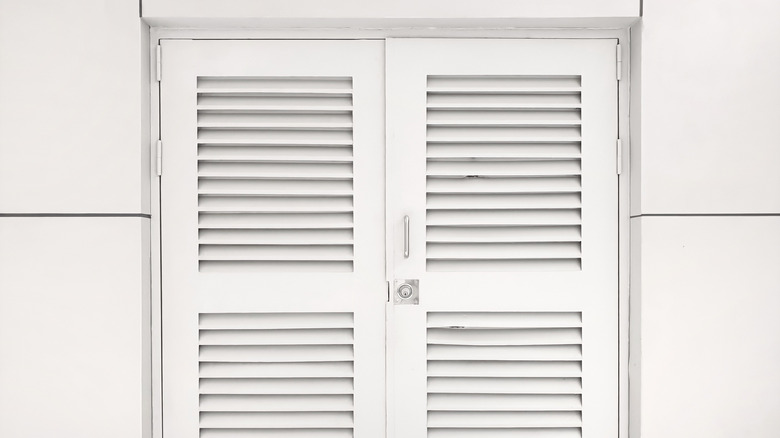Tips For Dusting Those Hard-To-Reach Crevices In Louvered Closet Doors
We may receive a commission on purchases made from links.
Most people have a set routine for cleaning their homes. They tackle all the major things that get dirty over the week, from vacuuming carpets to mopping floors to wiping down countertops. But every so often we jump into a deep cleaning session where we scrub down all the places in our homes that we normally don't get to. These are the nitty-gritty areas that would take too long to tackle on a weekly basis, such as the carvings on wooden furniture, the books on library bookcases, and the protruding panels on doors. The last one is especially easy to miss since not a lot of dust accumulates there, but there is one door type that might need more frequent dusting than many similar doors — a louvered closet door.
Louvered doors are made with horizontal slats that cover their entire faces. The slats not only add design interest but they also allow air to circulate in and out of the closet. While it might be beneficial, one of the main downsides of this door is that dust settles on each slat just like it does on blinds. Because of this, a thorough cleaning is required about once a month to ensure the dust doesn't get caked on. However, it can be a little tricky getting into the tight spaces between the slats to clean them. Here are some easy ways to do so.
Use a ruler with a microfiber cloth
It's difficult to get into the crevices of a louvered door — most fingers can't get into those tight spaces at the very back. One of the most efficient ways to get around this problem is to use a ruler (or butter knife) wrapped in a microfiber cloth. Saturate the fabric with an all-purpose spray to help pick up the dust. If you don't like using commercial cleaners, you can just as easily use vinegar as a cleaning tool. Just pour it into a spray bottle, add 10 to 15 drops of your favorite essential oil for a scent boost, and saturate the cloth with that instead. Once ready, insert the ruler or butter knife into each slat, rubbing it back and forth a few times to pick up the accumulated dust. If there is a lot, make sure to replace the cloth every so often so you're not cleaning with a dirty rag.
Once done, you might find that there is some dust stuck in the corners of the slats that your butter knife or ruler couldn't get to. To remove that stubborn dust, grab a 1-inch paintbrush to flick it away. The bendable bristles should allow you to get into those tricky corners; then you can use them to brush the dirt away from the crevices. Just make sure you're using a new brush and not an old one that's stiff with dried paint. Obviously, a stiff brush won't be able to remove dust as well.
Get a specialized tool
If you're the type of person who's more motivated to clean if you have the right tools, then skip the DIY butter knife route and instead get a special duster tool. It looks like a pair of tongs wrapped in microfiber cloth, but instead of two blades, it has three. This allows you to clean the tops and bottoms of two slats at once and get through the task much faster. The concept is the same. Saturate the cloth with your cleaning solution of choice and wipe it back and forth against each slat. For an even faster application, you can mix a bucket of water with either dish soap or vinegar and then dunk the tool in to saturate it. When it gets dirty with dust, you can dunk it back to remove some of the dirt from the cloth and soak it with more cleaning liquid.
You can easily get this tool at big box stores or online. For example, the Kakasi louver cleaning tool gives you three tongs for $10.99 on Amazon. You can slip off the microfiber sleeves and wash them after use. The end also comes with an attached soft bristle brush, which allows you to clean any stubborn corners without having to hunt down a second tool. This will make the cleaning task much easier, which will make you more likely to do it. Follow these cleaning tips to make your doors seem as good as new.

